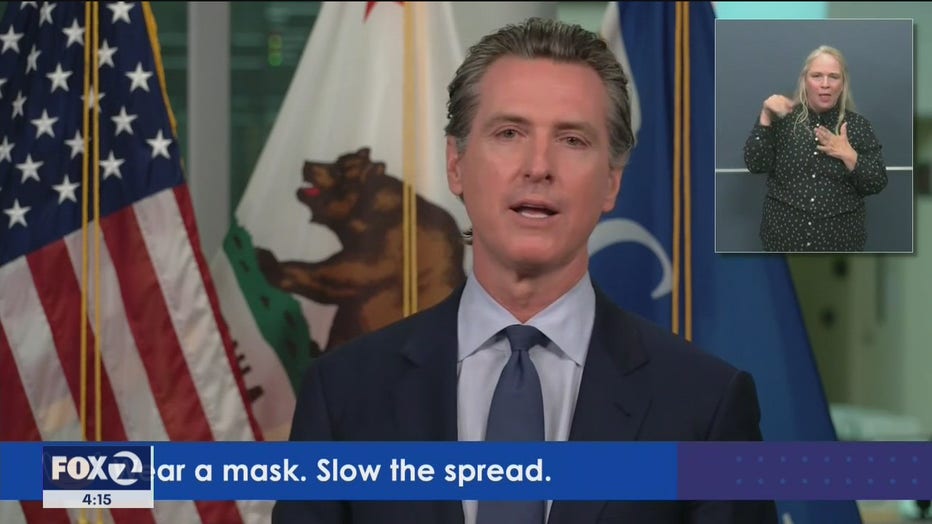Gov. Newsom prepares today to announce guidance for California school reopenings

Are schools safe to reopen?
Sen. Steve Glazer and State Superintendent Tony Thurmond discuss reopening California's schools amid the coronavirus pandemic.
SACRAMENTO, Calif. - Gov. Gavin Newsom today will announce new guidance for the reopening of California schools.
Many of the state’s 1,000 districts are just weeks away from their first day of instruction for the fall.
Several school districts have already announced their schools will begin the new term virtually, including Los Angeles and San Diego, the state’s two largest with a combined population of 720,000 K-12 students. San Francisco, Oakland, San Jose, Sacramento, Long Beach, Santa Ana and San Bernardino are among the other districts opting not to immediately return to classrooms.
The decisions were made amid growing concern from teachers and parents over the state’s surge of coronavirus cases and uncertainty surrounding the safety of both students and staff on campuses. The state this week reported its second-highest one day totals in infection rates and deaths since the start of the pandemic and more than 7,200 have died.
State officials have placed 32 of California’s 58 counties on a watch list because of concerning coronavirus transmission and hospitalization rates. Being on the list puts restrictions on the ability to reopen various segments of the economy.
Earlier this week, Newsom said he had approved new rules on wearing masks, playing sports, singing, busing and “keeping our kids safe and furthering our efforts around distance learning.” His administration did not immediately make those rules public but his office said Newsom would “announce COVID-19 guidance for schools” on Friday.
The decision of whether to reopen rests with local districts and school boards, but Newsom’s administration and the state Department of Education released guidelines in early June for districts to follow when reopening, which include implementing temperature checks for students, remaking activities such as lunch and recess, and recommending cloth face coverings for students and teachers.
“Since we’ve issued our guidance, conditions have changed dramatically,” State Superintendent of Public Instruction Tony Thurmond said during a media briefing Wednesday, adding that he expects more districts will decide to begin the term virtually. “In any place where there is uncertainty, we should proceed with caution. In many cases, that’s going to be opening in distance learning.”
Many small, rural communities argue they shouldn’t have to comply with the same rules as big cities where infection rates are higher. Thurmond indicated Wednesday he agreed.
Meanwhile, a group of state officials and representatives of multiple Bay Area school districts held a virtual discussion Thursday on how to safely resume in-person education during the COVID-19 coronavirus pandemic.
Sen. Steve Glazer, D-Orinda, Assemblywoman Rebecca Bauer-Kahan, D-Orinda, and State Superintendent of Public Instruction Tony Thurmond joined the superintendents of the Pittsburg, Lafayette and Livermore unified school districts to discuss how the pandemic will affect the fall semester and how to keep teachers, students and their families safe.
Thurmond said the state will collaborate with individual school districts to determine their reopening plans but will defer to each district if they feel continuing classes online is the safest route to take.
"I'm a former school board member; I care deeply about local decision-making and the way things have been set up is that local boards and superintendents make decisions informed by local county health officers," Thurmond said.
At least to start the semester, Thurmond said the state is advising school districts to continue with distance learning like they ended the spring semester.
School districts across the state have also appealed to both the state and private industry to help address the "digital divide," of students who don't have access to reliable internet service or a computer at home.
Pittsburg Unified School District Superintendent Janet Schulze said the district placed emergency orders earlier this year to acquire "significant numbers" of Google Chromebooks that students could check out and use to attend classes at home.
Schulze also estimated that about 15 percent of students were not completely engaged in distance learning during the spring semester.
"That was very concerning," she said. "We had multiple efforts in terms of reaching out to families and trying to do some home visits as well to make sure that we could connect with all of our families, including our homeless and our foster youth families as well."
Thurmond also took a shot at President Donald Trump's recent threats to essentially hold federal education funding hostage unless schools reopen for in-person classes for the fall semester.
"With all due respect to the president's comments, I think now is the time for caution, now's the time for safety, not inflammatory remarks," he said. "I just have to call it was it is -- it's dangerous, it's reckless and it's immoral to threaten to cut funding for schools."
Thurmond said he has asked the state's Department of Public Health to create a rubric or metric of some kind that school districts can monitor that will tell them when to suspend in-person classes and resume at-home instruction.
The state Department of Education has also arranged for a meeting with all of the state's districts and the California Department of Public Health to clarify the state's guidance about reopening schools.
"I think we feel your angst, your stress, your worry in terms of what's happening right now," Glazer said. "We're living in this pandemic in real time and I know that we are all working very hard to try to make good choices about health and about safety."


